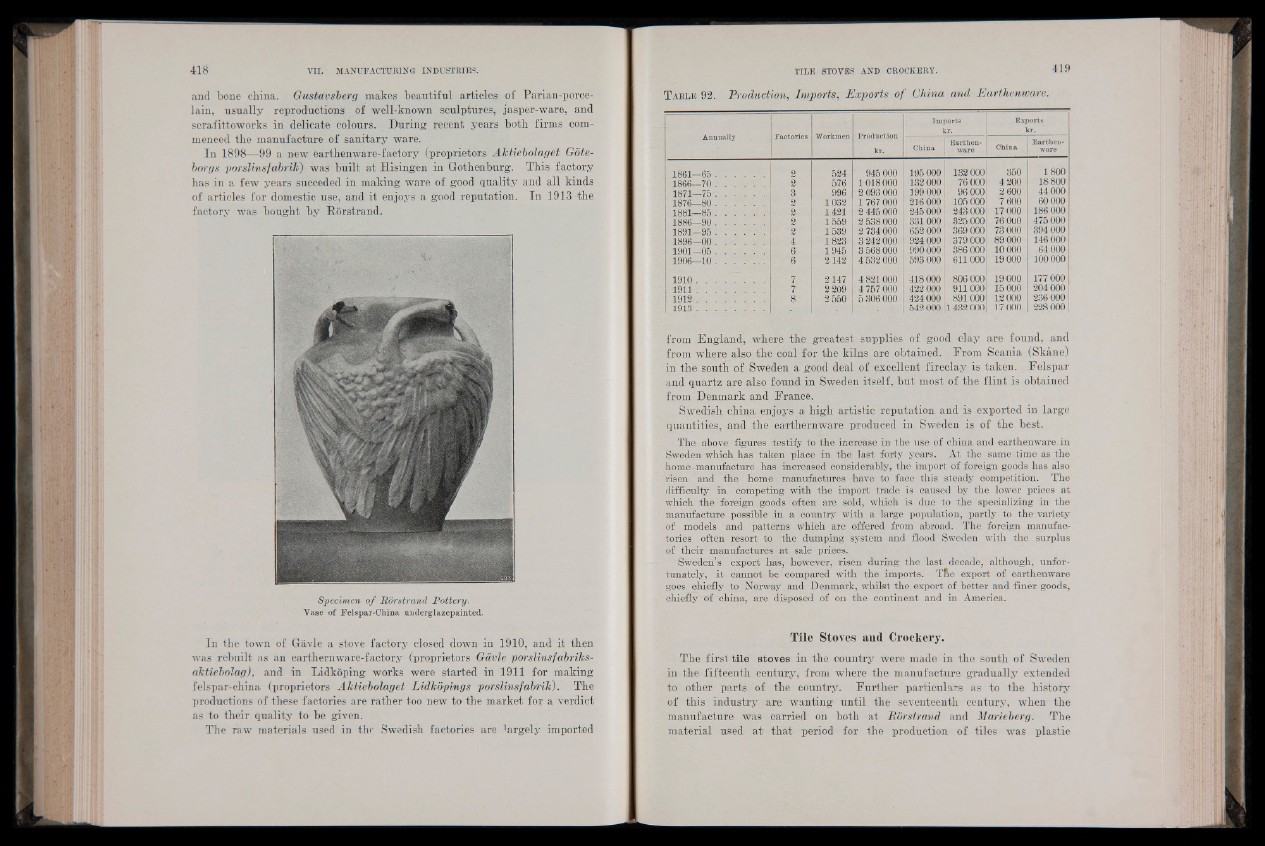
and bone china. Gustavsberg makes beautiful articles of Parian-porcelain,
usually reproductions of well-known sculptures, jasper-ware, and
scrafittoworks in delicate colours. During recent years both firms commenced
the manufacture of sanitary ware.
In 1898—99 a new earthenware-factory (proprietors Aktiebolaget Göteborgs
porslinsfabrik) was built at Hisingen in Gothenburg. This factory
has in a few years succeded in making ware of good quality and all kinds
of articles for domestic use, and it enjoys a good reputation. In 1913 the
factory was bought by Rörstrand.
Specimen o f Pörstrand Pottery.
Vase of Felspar-China anderglazepainted.
In the town of Gavle a stove factory closed down in 1910, and it then
was rebuilt as an earthernware-factory (proprietors Gdvle porslinsfdbriks-
aktiebolag), and in Lidkoping works were started in 1911 for making
felspar-china (proprietors Aktiebolaget Lidkopings porslinsfabrik). The
productions of these factories are rather too new to the market for a verdict
as to their quality to be given.
The raw materials used in the Swedish factories are ’argely imported
Table 92. Production, Imports, Exports of China and Earthenware.
Annually Factories Workmen Production
kr.
Imports
kr.
Exports
kr.
China
Earthenware
China
Earthenware
1861-65 .................... 2 524 1 945 000 195 000 132 000 350 1800
1866—70 .................... 2 576 1018 000 132 000 76 000 4 200 18 800
1871 -75 . . . . 3 996 2 093 000 199 000 96 000 2 600 44 000
1876—80 .................... 2 1032 1 767 000 216 000 105 000 7 600 60 000
1881—85 .................... 2 1421 2 445 000 245 000 243 000 17 000 186 000
1886—90 .................... 2 1559 2 538 000 331 000 325 000 76 0U0 475 000
1891—95 .................... 2 1539 2 734 000 652 000 369 000 73 000 394 000
1896-00 .................... 4 1823 3 242 000 924 000 379 000 89 000 146 000
1901-05 .................... 6 1945 .3 568 000 990000 386 000 10 000 64 000
1906—10 .................... 6 2142 4 532 000 593 000 611000 19 000 100 000
1910............................ 7 2147 4 821000 418 000 806 000 19 000 177 000
1911............................ 7 2 209 4 757 000 422 000 911000 15 000 204 000
1912............................ 8 2 550 5 306 000 424 000 891 000 12 000 236 000
1913.. m ................ 542 000 1432 000 17 000 228 000 |
from England, where the greatest supplies of good clay are found, and
from where also the coal for the kilns are obtained. From Scania (Skane)
in the south of Sweden a good deal of excellent fireclay is taken. Felspar
and quartz are also found in Sweden itself, but most of the flint is obtained
from Denmark and France.
Swedish china enjoys a high artistic reputation and is exported in large
quantities, and the earthernware produced in Sweden is of the best.
The above figures testify to the increase in the use of china and earthenware in
Sweden which has taken place in the last forty years. At the same ¡time as the
home manufacture has increased considerably, the import of foreign goods has also
risen and the home manufactures have to face this steady competition. The
difficulty in competing with the import trade is caused by the lower prices at
which the foreign goods often are sold, which is due to the specializing in the
manufacture possible in a country with a large population, partly to the variety
of models and patterns which are offered from abroad. The foreign manufactories,
often resort to the dumping system and flood Sweden with the surplus
of their manufactures at sale prices.
Sweden’s export has, however, risen during the last decade, although, unfortunately,
it cannot be compared with the imports. Tne export of earthenware
goes chiefly to Norway and Denmark, whilst the export of better and finer goods,
chiefly of china, are disposed of on the continent and in America.
Tile Stoves and Crockery.
The first tile stoves in the country were made in the south of Sweden
in the fifteenth century, from where the manufacture gradually extended
to other parts of the country. Further particulars as to the history
of this industry are wanting until the seventeenth century, when the
manufacture was carried on both at Rorstrand and Marieberg. The
material used at that period for the production of tiles was plastic